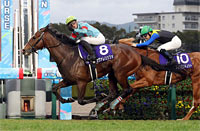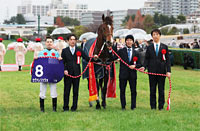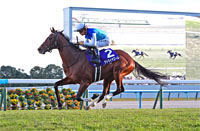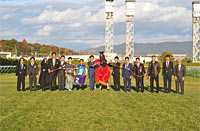2015 News
Data Analysis for the "2015 Asahi Hai Futurity Stakes (G1)"Potential future stars meet to decide the champion 2-year-old Held at Nakayama Racecourse for the first 65 occasions until 2013, the Asahi Hai Futurity Stakes changed its venue to Hanshin for its 66th showing last year. Of the strong finishers in that inaugural race, 3rd-placed Clarity Sky went on to win this spring’s NHK Mile Championship, while the winner Danon Platina also took the autumn’s Fuji Stakes. This could certainly be seen as an important race, with an eye both on next spring’s 3-year-old G1 program and on graded races later in the year. This time, let’s analyze trends shared by successful performers in this race from results over the last 10 years (including 2005-2013, when it was held at Nakayama). Look for distance aptitude Each of the last 10 winners had already experienced wins in JRA races over distances of 1,500m or more. Horses without such experience have performed poorly, with a top 3 ratio of 9.5%. We shouldn’t expect too much from runners with no experience of wins except over distances of 1,400m or less. [Table 1] [Table 1] Performance by experience of wins in JRA races over 1,500m or more (last 10 years)
Pre-race buildup is important Looking at aggregate performances over the last 10 years by the condition of the previous race, 19 of the 30 top 3 finishers had most recently appeared in “JRA graded races”. By contrast, horses last seen in “Other races” have struggled somewhat, scoring a top 3 ratio of only 14.5%. In this race, it seems best to focus on runners coming straight from “JRA graded races”. [Table 2] [Table 2] Performance by condition of the previous race (last 10 years)
However, of runners most recently contesting “JRA graded races”, none of those beaten to “5th or lower” in that race has won the Asahi Hai FS. In fact, horses in this category have only managed a measly top 3 ratio of 3.8%. So even when the previous outing was a JRA graded race, we should lower our expectations if the horse failed to finish in the top 4. [Table 3] [Table 3] Performance by finish in the previous race when it was a JRA graded race (last 10 years)
When the previous race was not a JRA graded race, no horse finishing “2nd or lower” in that race has performed successfully here. And finishing “1st” is no guarantee of success, either; no winning horse with a time difference of “0.1 seconds or less” ahead of the runner-up has won this race. When considering runners coming from anything other than “JRA graded races”, our focus should be on winners with a time difference of “0.2 seconds or more” ahead of the runner-up in that race. [Table 4] [Table 4] Performance by finish in the previous race and time difference ahead of the runner-up when it was not a JRA graded race (last 10 years)
Discount early runners, pressers and closers Turning to performances over the last 10 years by the position at the 4th corner in the previous race, 18 of the 30 top 3 finishers here had passed the 4th corner in “3rd-6th” position last time out. On the other hand, horses passing the 4th corner in “1st or 2nd” or “7th or lower” position have managed middling results at best. Even last year, when the race was held at Hanshin Racecourse for the first time, the winner Danon Platina had passed the 4th corner in 4th position in his last race, while runner-up Arma Waioli and 3rd-placed Clarity Sky had both done so in 3rd. We should perhaps shy away from early runners, as well as pressers and closers (i.e. runners that prefer to attack from the center or rear of the pack). [Table 5] [Table 5] Performance by position at the 4th corner last time out (last 10 years)
Inner brackets dominate – including last year On checking performances by bracket number over the last 10 years, we find that 16 of the 30 top 3 finishers started in brackets “1-3”. Horses in brackets “4-8” have performed somewhat less impressively by comparison, achieving a top 3 ratio of just 13.9%. Even last year, when the race was first held at Hanshin, the winner Danon Platina was horse number 2 in bracket 1 while runner-up Arma Waioli was number 6 in bracket 3. It may be best to focus on runners starting from the inner brackets again this year. [Table 6] [Table 6] Performance by bracket number (last 10 years)
Strong recent showing when last race was also 1,600m Viewing performances by the distance of the previous race over the last four years, eight of the 12 top 3 finishers in that time had contested a race over “1,600m” last time out. Horses in this category also have high success ratios, including a top 3 ratio of 38.1%. Given trends in recent years, we should be focusing on runners most recently seen in races over “1,600m”, like this one. [Table 7] [Table 7] Performance by distance of previous race (last 4 years)
Seek out the winner! Each of the last four winners had contested a race over 1,600m last time out. What’s more, these four had all won that race with a time difference of 0.2 seconds or more ahead of the runner-up. In fact, only seven horses have satisfied all of these conditions over the last four years – and that includes the winners. If any of this year’s runners falls into this category, they could definitely be worth a punt. [Table 8] [Table 8] Winners’ previous race, finish and time difference ahead of runner-up in previous race (last 4 years)
(Data analysis by Masaya Ibuki) |
|
||||||||||||||||||||||||||||||||||||||||||||||||||||||||||||||||||||||||||||||||||||||||||||||||||||||||||||||||||||||||||||||||||||||||||||||||||||||||||||||||||||||||||||||||||||||||||||


















